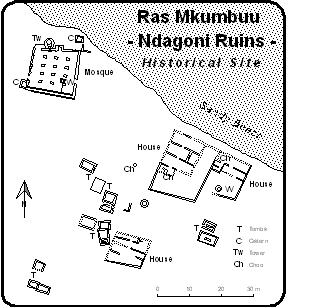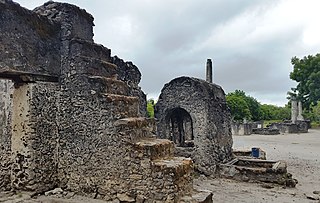
Pemba Island is a Tanzanian island forming part of the Zanzibar Archipelago, lying within the Swahili Coast in the Indian Ocean.

Pemba South Region or South Pemba Region is one of the 31 regions of Tanzania. The region covers an area of 332 km2 (128 sq mi). The region is comparable in size to the combined land area of the nation state of Grenada. and the administrative region is located entirely on the island of Pemba. Pemba South Region is bordered to the south by Indian Ocean, north by Pemba North Region and the west by Pemba channel. The regional capital is Mkoani.. The region has the fifth highest HDI in the country, making one of the most developed regions in the country. The region has the highest standard of living on Pemba Island. According to the 2012 census, the region has a total population of 195,116.

Tumbatu is historic Swahili settlement located on Tumbatu Island, Kaskazini A District of Unguja North Region in Tanzania. This site is a significant archaeological site that contains a large number of collapsed coral stone structures including private houses and several mosques, the largest of which is located on the shore facing the village of Mkokotoni on Unguja. Pearce initially looked into the ruins in 1915 and wrote about the mosques, palace, and other stone homes.
Chambani is a historic site and village located in Mkoani District of Pemba South Region. Its one of several National Historic sites on the island of Pemba. The site is located nine kilometres south of Chake-Chake, close to several sets of ruins, notably the Pujini Ruins, a 15th-century citadel, located close to the village of Pujini, two kilometres to the north.

Ras Mkumbuu Ruins are located in Chake Chake district of South Pemba Region. They lie close to the village of Ndagoni at the end of a long narrow peninsula known as Ras Mkumbuu, which lies to the northwest of the town of Chake-Chake. The ruins mainly date from the 9th century CE and were abandoned in the 16th century, though there are indications that they were built over older foundations. Notable among these ruins are those of a large mosque which was for some time the largest structure of its type in sub-Saharan Africa. James Kirkman, the first archeologist to excavate here in the 1950s, proposed to connect his findings with the "Qanbalu" mentioned by the Arab explorer Al-Masudi around 900 but could not identify remnants earlier than the 13th century . A possible identification of Pemba Island as a whole and especially Ras Mkumbuu with Qanbalu is still discussed.

Kaole is a national historic site located in Bagamoyo District of Pwani Region in Tanzania. The site is located three miles east of the historic city of Bagamoyo on the Indian Ocean coast. The area contains old Swahili coral stone ruins dating to a period between the 13th century and the 16th century. Some of the ruins date back to the 13th century and consist of two mosques and 30 tombs.

Pemba Island is a large coral island off the coast of Tanzania. Inhabited by Bantu settlers from the Tanga coast since 600 AD, the island has a rich trading, agricultural, and religious history that has contributed to the studies of the Swahili Coast trade throughout the Indian Ocean.

National Historic Sites of Tanzania is an official list of places in Tanzania that have been designated as National Historic Sites as per the Ministry of Natural Resources and Tourism of Tanzania under the Antiquities Division. The list is not complete and is currently being updated.

Mkama Ndume Ruins was a medieval Swahili settlement palace ruins located in Chake Chake District of Pemba South Region that was abandoned in the 16th Century prior to Portuguese arrival and is known for its fortification. The site is located 10 km (6.2 mi) east of the town of Chake-Chake. The settlement was ruled by a leader named Mohammed bin Abdul Rahman, who was known for his cruelty towards his subjects thus earned his infamous nickname Mkama Ndume meaning milker of men in old Swahili. The settlement ruins bear this nickname.

Pujini Ruins is a Medieval historic site next to the village of Pujini located in Chake Chake District of Pemba South Region. There used to be a fortified palace at the site, only ruins of the walls remain. The palace is believed to have been of Mkame Mdume. Its one of several National Historic Sites on the island of Pemba including Chambani and Ras Mkumbuu.

Chwaka is a medieval Swahili historic site next to the village of Chwaka located in Micheweni District of Pemba North Region, Tanzania. There is an excavated Swahili mosque on the site. The location of these ruins is 6 km (3.7 mi) from the small town of Konde, at the end of a trail that extends 900 m (3,000 ft) in the direction of the village of Tumbe on the way to the village of Myumoni.
Mtambwe Kuu or Mtambwe Mkuu is a Medieval Swahili historic site located in Chake Chake District of Pemba North Region. A town wall, a mosque, tombs, and residences are among the several stone constructions at the Mtambwe Mkuu site in northwest Pemba. The oldest indications of occupation date from the eleventh century and persisted successfully and unbrokenly until the fifteenth century. It was once again occupied in the nineteenth century. A cache of over 2,000 gold and silver coins from the 10 and eleventh centuries were found during an excavation at the location, demonstrating Pemba's Swahili involvement in the regional trade networks at the time.
Tumbe is an early Medieval Swahili historic site next to the village of Tumbe located in Micheweni District of Pemba North Region. Between 600 and 1000 AD, the city of Tumbe served as the island's primary location. There is sufficient evidence that this city served as a major commerce hub for the Indian Ocean. Smaller sites from the eighth to tenth centuries AD were grouped together around the major metropolis.
Shamiani is protected historic site located inside Mkoani District of Pemba South Region in Tanzania. The site is home to partially excavated abandoned medieval Swahili ruins with a brief occupation period from about 14th to 16th century.

Msuka Mjini Ruins is protected historic site located inside Micheweni District of Pemba North Region in Tanzania. Msuka Mjini has a Swahili mosque from the fifteenth century preserved in ruins on the Kigomasha peninsula on the island. The date 816AH is carved on the interior of the circular mirhab.
Mduuni Ruins is protected historic site located inside Micheweni District of Pemba North Region in Tanzania. The settlement was established around 1100 CE.
Mkia wa Ng'ombe Ruins is protected historic site located inside Micheweni District of Pemba North Region in Tanzania. The settlement was established around the 15th CE and abandoned in the 16th century. There are ruins of a mosque, tombs and some stone buildings. The site is critically endangered to further erosion.

Kimbiji Ruins is a Medieval Swahili, National Historic Site located in Kimbiji ward of Kigamboni District in Dar es Salaam Region of Tanzania. Although the site has been vandalized by an illegally felled tree that fell on the mosque, the Tanzanian government is working to launch restoration measures as soon as possible.

Mbuamaji or sometimes spelled Mbwamaji is a Medieval Swahili, National Historic Site located in Somangila ward of Kigamboni District in Dar es Salaam Region of Tanzania. Despite years of neglect that resulted in vandalism, the Tanzanian government is aiming to start restoration efforts as soon as possible.

Mbutu Bandarini Ruins(Swahili: Magofu ya mji wa kale wa Mbutu Bandarini) is a Medieval Swahili, National Historic Site located in Somangila ward of Kigamboni District in Dar es Salaam Region of Tanzania. Despite years of indifference that led to vandalism of the site, the Tanzanian government has contracted a firm to begin repair operations as soon as feasible.













